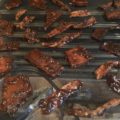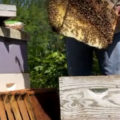I was asked recently about my cheese press and if I would be willing to show some pics and explain it. I’m always happy to
It’s rudimentary, but it gets the job done. It’s the only one I’ve ever used and I still use it today. Sure there are some quirks that I’ll explain, but with a little thought, maybe I’ll eventually figure out the clever tweaks it needs. Anyone can look around on the net and find ideas, and maybe even some plans. I refused to buy any because of the simple nature of the device. I also wanted something that I could tuck away when I wasn’t using it. Hence, the design is my own.
First, here is what it looks like when it’s collapsed and ready for storage.

The black base was a piece of scrap counter top that was cut out for the sink. This is particle board in nature, but it’s compact, and of course, has a piece of Formica laminated on the top. So far, so good, over the many years it’s been used, there’s no sign of de-lamination yet. However, the acid from the draining whey has discolored and stained it a bit. I wanted to bottom to be durable, smooth, and sanitary since that is where the cheese mould would be sitting… on a corrugated may, of course, to allow the whey to run out from under.

From the pic above, you can see that I have a hinge holding on a 2×4 that can be tipped up when it’s time to use it. The block under the 2×4 is simply for stability. Another critical piece is the wire coat hanger that goes from the top of the 2×4 back down to the front of the base. This is critical to hold things steady as we swap out various weights during use. You can see this in the next pic.

Next, are the lever arm and the plunger. Both were made out of some scrap walnut that I had laying around. The shapes are my own. I just drew some sketches and based them off many of the presses I have seen on the internet. I knew what the press would have to do. Sometimes, based on the height of the cheese

Here is the press fully assembled. When I use it, I hang the front edge over the side of the sink on my counter. It let’s the whey drip into the sink and I can leave the press set up for as long as it’s needed.

Now, the quirks… or should I say quirk. There’s only one. We need to adjust the amount of weight that we are pressing with. Typically, you start low, say 5 or 10 pounds of weight, for 30 mins to an hour, then increase to maybe 20 pounds for an hour, then 50 pounds for 2 hours, 75 pounds for 5 hours, and then maybe even 100 pounds, etc. Different cheese have different weights and times. The idea is that when you press low, you are allowing the proper amount of whey to escape from around the curds. If we pressed with too much weight too soon, then we actually trap whey inside. The whey is acidic and it develops the cheese in different ways. The right amount of whey need to be evacuated at the proper rate so that acidity is properly managed. That said, I use my bathroom scale under the plunger and then I add weight with whatever I have laying around to get it there. It used to range from a dutch oven hanging on the lever with stuff in it, to my more modern approach of using real bench weights. Also, weight can be adjusted simply by where you position the weights on the lever arm. So, a 5lb weight could actually weight more when it’s moved out to the furthest end of the lever arm. Notice the blue rubber band on the lever arm. That simply holds whatever I have on the arm from slipping in the even the arm is angled downward slightly. If it’s too far downward, then I can adjust the plunger lower by selecting a higher hole on the plunger arm.


So that’s it. I’d love to hear your thoughts, ideas, and maybe even hear about the press you made. I’m sure this could be improved upon. Who knows, I may one day buy a real cheese press but as long as this one keeps doing what it does, there’s no need. I do love upcycling and any excuse to re-use the stuff that I tend to squirrel away for the right need.





Hi
I love your design! Is it still working well for you?
I would love some rough measurements if at all possible.
If I didn’t want it fold down, a triangular piece of wood on the back of the upright should keep it stable, instead of the wire?
Thanks in advance
Trish
Yes, working very well and I still use it regularly. I would have to get some measurements but what’s most important is the lever (adding some length in order to position a weight on it in various places to adjust weight. You also need a way to hold it down for when you get weight further out on the lever. What specific measurements would you like? I can take them and give to you. Since it was completely made by just looking at other pictures, there were no measurements that I took 🙂 But I’m happy to send you any specific measurements you;’d want.
Thanks
The height of the back piece, length of press, the length of lever. Just rough measures is ok. Metric if possible
Hi Trish, sorry for my delay in response. The holidays kept me busy! Here are the measurements:
Back piece: 50.8cm
Lever: 67.5cm
Bottom tray: 48.2cm
Couldn’t you put the mold and curd directly on the scale then add weight to the desired pressure?